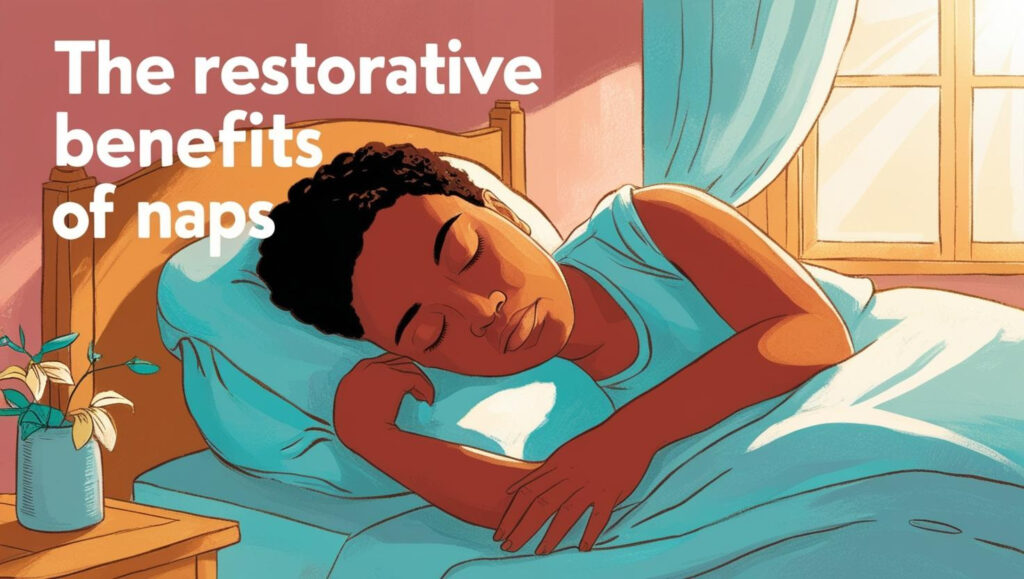Can we boost our energy and creativity in just a few minutes? Yes, that’s the power of a power nap, which brings incredible healing benefits to everyday life. These short and effective naps recharge your body and sharpen your mind. They are like little spa treatments for your brain, helping you bounce back with a fresher perspective.
Power naps are brilliant for improving memory and mood. Just think of how a machine needs a quick shut-off to work smoothly, so does our brain. If you’re seeking a key to enhance productivity and health, power naps are your ticket 🎟️. Dive into the world of restful benefits and let power naps transform your day!
Understanding Power Naps
Power naps have become a widely discussed topic due to their potential to offer significant benefits with just a small investment of time. By recognizing what constitutes a power nap, along with its ideal duration and historical context, we can better integrate such restful breaks into our daily routine.
Definition and Duration
Power naps are short naps intended to rejuvenate and regain energy in a short period, typically ranging from 10 to 30 minutes. Such naps are known not for entering deep sleep but for providing a quick boost to the system, counteracting sleepiness, and enhancing performance.
Optimal Length for a Power Nap
The optimal length for a power nap is around 20 minutes. Experts suggest this duration as it allows the body to stay in the lighter stages of sleep, averting the grogginess that comes from entering deeper sleep stages, often referred to as “sleep inertia.” Keeping naps short ensures you wake up feeling refreshed and alert, rather than groggy and disoriented.
Differences Between a Nap and Long Sleep
Understanding the difference between a nap and a long sleep is crucial. Naps, especially power naps, are brief, aiming at quick recovery and instant revitalization. Long sleep, typically spanning 7–9 hours, allows the body to progress through multiple sleep cycles, deeply restoring cognitive and physical health over an extended period. While naps offer immediate benefits, long sleep is essential for overall well-being, crucial to long-term health and productivity.
History and Evolution of Napping
The art of napping has evolved over centuries, with various cultures adopting and adapting this practice as per societal needs. Understanding its history provides insight into its significance and potential benefits across different eras and regions.
Cultural Perspectives on Napping
Throughout history, cultural perspectives on napping have varied significantly. In Spain, the “siesta” is a cherished tradition, where people take a break in the afternoon to rest and recharge. In contrast, in countries like Japan, inemuri, or sleeping on the job, is viewed positively, symbolizing hard work and dedication. These cultural variations reflect how different societies perceive and integrate napping into daily life.
The Role of Napping in Different Societies
Napping has played diverse roles in different societies. While some societies view napping as a crucial part of daily schedules, others consider it a luxury. For instance, in Mediterranean and South American cultures, it is a norm and often scheduled after lunch to rejuvenate and boost productivity for the remainder of the day. Conversely, in fast-paced Western cultures, napping might be less common, yet its benefits are now gaining recognition as work-life balance becomes a priority.
As an energizing tool, power naps harness the benefits of napping, combining modern research with ancestral wisdom to offer a simple yet powerful way to enhance daily functioning.

The Healing Benefits of Power Naps
Understanding the healing benefits of power naps can greatly enhance various aspects of your life. Let’s delve into how a simple, short slumber can be a game-changer for your mental, cognitive, and physical well-being.
Mental Health Boost
Power naps are a fantastic resource for boosting mental health and tackling problems that might otherwise weigh you down.
Stress Reduction
One of the most significant benefits of power naps lies in their ability to reduce stress. During a nap, your brain gets a chance to reset and relax. This downtime leads to lower levels of cortisol, the stress hormone that can negatively impact your health. As a result, a power nap can make you feel less anxious and more composed upon waking, giving you a much-needed break from the hustle and bustle of daily life.
Improvement in Mood
In addition to reducing stress, power naps contribute significantly to an improvement in mood. Even in short bursts, sleep releases serotonin, a chemical known for its mood-enhancing properties. This can leave you feeling brighter, more optimistic, and ready to face the rest of your day with positivity. After a power nap, you might find yourself more smiley and pleasant to yourself and those around you 😊.
Cognitive Enhancements
The connection between power naps and cognitive performance is simply impressive. These short naps can enhance your brain’s abilities in remarkable ways.
Memory Improvement
One of the standout cognitive benefits of power naps is their potential to improve your memory. During a nap, the brain engages in a process known as memory consolidation, where it better retains and organizes information. This boost in memory efficiency means that after a nap, you’ll likely find it easier to recall facts and figures, recognize patterns, or retrieve previously learned details.
Better Learning Abilities
Power naps are helpful in memory enhancement and improve learning abilities. After a brief nap, the brain’s propensity for learning and absorbing new information can be heightened. This means a power nap can sharpen your attention, allowing for longer periods of active and engaged learning. It’s a small investment of time for a significant return in learning capacity.
Physical Benefits
Not only do power naps refresh the mind, but they also have profound effects on your physical vitality.
Increased Energy Levels
A quick nap can swiftly elevate your energy levels. By allowing your body a moment to rest, power naps recharge your internal battery, giving you a burst of vigor to help you power through the rest of your day. This small pause can make a world of difference, transforming feelings of tiredness into newfound enthusiasm.
Enhanced Physical Performance
Finally, power naps can enhance physical performance. Athletes and everyday individuals alike can benefit from the recuperative effects of a quick nap. By reducing fatigue and enhancing muscle recovery, a power nap can lead to improved strength and coordination, ultimately elevating overall physical performance.
Integrating power naps into your daily routine can transform your life, providing a myriad of healing benefits. Whether you’re addressing mental health, cognitive functions, or physical vitality, taking the time for a short nap is a simple yet powerful step towards a healthier, more balanced life.
Scientific Insights on Power Napping
Power naps are not just a lazy indulgence; they have become a subject of scientific investigation, revealing multiple dimensions of their potential health benefits. Understanding the scientific insights behind power napping uncovers how these short naps can be integrated into effective wellness strategies. Let’s delve into the exciting research and biological mechanisms underpinning power naps’ positive effects.
Research Studies and Findings
Research studies have explored power naps and revealed amazing revelations about their benefits for mental and physical health. One spotlight area is the implications for brain function and overall health, which offer real insights into why power naps are more beneficial than they might first appear.
Impact on Brain Function
Power naps have been shown to profoundly impact brain function. Research indicates that even a brief nap can enhance cognitive processes such as alertness, focus, and creativity. Scientists have discovered that the brain takes this opportunity to consolidate memories and even make new connections, leading to a sharper mind post-nap.
Moreover, power naps can reduce mental fatigue by giving the brain a rest period, like a reset button that revives and rejuvenates its functioning capabilities. This quick restoration has been demonstrated through MRI scans, which show an increase in brain activity following a power nap, especially in areas related to problem-solving and complex decision-making.
Relations between Napping and Health
The links between napping and health are equally compelling, with studies highlighting numerous long-term health benefits. Consistent power napping is associated with lower stress levels and can contribute to a healthier lifestyle. This is because napping influences various physiological processes that are instrumental in maintaining health.
Current research points to reduced risks of cardiovascular diseases for regular nappers. It’s astonishing how just a few minutes of shut-eye can help regulate bodily functions, enhance heart health, and significantly lower the risk of medical issues. These findings strongly endorse incorporating power napping into one’s daily routine for improved overall well-being.
Biological Mechanisms Behind Power Naps
Delving deeper into the biological mechanisms, power naps are intricately linked to our body’s inner workings, affecting hormonal cycles and biological rhythms. These mechanisms provide a scientific basis for their effectiveness.
How Power Naps Affect Circadian Rhythms
Circadian rhythms control the natural cycle of sleep and wakefulness in our body. Power naps significantly modulate these rhythms, especially during the midday slump many people experience.
By synchronizing an afternoon nap to your circadian rhythm, you can reduce the feeling of grogginess and dramatically improve alertness without interrupting your nighttime sleep. Researchers suggest that power naps mimic certain stages of nighttime sleep, which trick the brain into believing it’s had a more extended rest period, thereby bringing about energetic benefits.
Napping and Hormone Regulation
When it comes to hormone regulation, naps can have a profound effect. During a power nap, the body enters a relaxed state, which can help balance key hormones like cortisol and reduce stress. Similarly, hormones related to appetite and insulin regulation, such as ghrelin and leptin, also stabilize, demonstrating how integral naps can be to metabolic health.
Regular monitoring of hormones and observing their changes pre and post-naps have shown beneficial shifts in hormonal balance, confirming that even a brief sleep can have widespread positive hormonal impacts.
In conclusion, the scientific insights into power napping reveal a complex yet incredibly beneficial relationship with our bodies. With so many health advantages backed by research, incorporating regular power naps into our everyday lives could be the simple change needed for a much healthier and happier lifestyle. 💤

Tips for Effective Power Napping
Optimizing your environment and timing can transform a simple nap into a revitalizing experience. Navigating the delicate art of power napping requires some preparation and strategic planning. This guide will steer you through the essentials for mastering the art of the nap. 💤
Creating the Ideal Nap Environment
Creating the ideal nap environment is fundamental to making your power nap effective and refreshing. A conducive and peaceful setting can significantly enhance the quality of your rest.
Comfortable Settings
Comfortable settings are crucial when designing your nap space. To achieve this, consider:
- Location: Find a quiet and peaceful place where you’re least likely to be disturbed. A cozy corner at home or a serene spot at work can work wonders.
- Temperature: Keep the environment cool and pleasant. A mild temperature aids relaxation, allowing you to drift into a restful nap easily.
- Comfortable Furnishings: Use a soft pillow and a light blanket. Whether reclining on a sofa or lying on a bed, ensure you’re supported and comfortable.
- Lighting: Dim the lights or use an eye mask to block out any intrusive light that might prevent you from falling asleep.
Minimizing Distractions
Minimizing distractions is another key component for an effective nap. Here are some tips:
- Silence Your Phone: Switch your phone to silent mode to prevent notifications, calls, or texts from waking you up.
- Use Earplugs or Headphones: Block out noisy environments with earplugs or gentle background music through headphones. White noise or nature sounds can also create a soothing atmosphere.
- Inform Those Around You: Let those around you know not to disturb you during your nap time, if possible, ensuring you get uninterrupted rest.
Timing and Scheduling
Timing and scheduling your power naps can make a significant difference in their effectiveness. Done right, naps can complement and enhance your nighttime sleep.
Best Times to Nap During the Day
Finding the best times to nap during the day is essential. Typically, the ideal window for a power nap is:
- Afternoon Slump: Between 1:00 PM and 3:00 PM is often referred to as the post-lunch dip where energy levels naturally wane.
- Avoid Late Afternoons: Napping too late in the afternoon can interfere with nighttime sleep patterns.
Balancing Power Naps with Nighttime Sleep
Balancing power naps with nighttime sleep helps maintain a healthy sleep cycle. Here’s how you can balance both:
- Duration Matters: Limit naps to 10-20 minutes. This duration helps prevent entering deeper sleep stages that can lead to grogginess and disrupt your normal sleep schedule.
- Consistency is Key: Keep your napping routine consistent. Regular timing can help normalize your body’s natural sleep-wake cycle.
Sticking to these tips will enable you to harness the full potential of power naps, ensuring you awaken feeling refreshed and energized for the rest of your day.





